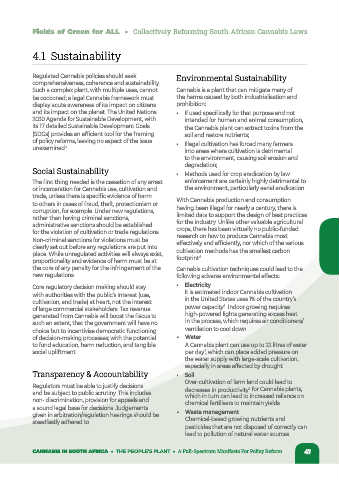Page 91 - Daggabay Magazine Issue 9
P. 91
Fields of Green for ALL • Collectively Reforming South African Cannabis Laws
4.1 Sustainability
Regulated Cannabis policies should seek Environmental Sustainability
comprehensiveness, coherence and sustainability.
Such a complex plant, with multiple uses, cannot Cannabis is a plant that can mitigate many of
be cocooned; a legal Cannabis framework must the harms caused by both industrialisation and
display acute awareness of its impact on citizens prohibition:
and its impact on the planet. The United Nations • If used specifically for that purpose and not
2030 Agenda for Sustainable Development, with intended for human and animal consumption,
its 17 detailed Sustainable Development Goals the Cannabis plant can extract toxins from the
(SDGs) provides an efficient tool for the framing soil and restore nutrients;
of policy reforms, leaving no aspect of the issue • Illegal cultivation has forced many farmers
unexamined . into areas where cultivation is detrimental
4
to the environment, causing soil erosion and
degradation;
Social Sustainability • Methods used for crop eradication by law
The first thing needed is the cessation of any arrest enforcement are certainly highly detrimental to
or incarceration for Cannabis use, cultivation and the environment, particularly aerial eradication.
trade, unless there is specific evidence of harm With Cannabis production and consumption
to others in cases of fraud, theft, protectionism or having been illegal for nearly a century, there is
corruption, for example. Under new regulations, limited data to support the design of best practices
rather than having criminal sanctions, for the industry. Unlike other valuable agricultural
administrative sanctions should be established crops, there has been virtually no public-funded
for the violation of cultivation or trade regulations. research on how to produce Cannabis most
Non-criminal sanctions for violations must be effectively and efficiently, nor which of the various
clearly set out before any regulations are put into cultivation methods has the smallest carbon
place. While unregulated activities will always exist, footprint .
5
proportionality and evidence of harm must be at
the core of any penalty for the infringement of the Cannabis cultivation techniques could lead to the
new regulations. following adverse environmental effects:
Core regulatory decision making should stay • Electricity
with authorities with the public’s interest (use, It is estimated indoor Cannabis cultivation
cultivation, and trade) at heart, not the interest in the United States uses 1% of the country’s
6
of large commercial stakeholders. Tax revenue power capacity . Indoor growing requires
generated from Cannabis will boost the fiscus to high-powered lights generating excess heat
such an extent, that the government will have no in the process, which requires air conditioners/
choice but to incentivise democratic functioning ventilation to cool down.
of decision-making processes; with the potential • Water
to fund education, harm reduction, and tangible A Cannabis plant can use up to 22 litres of water
social upliftment. per day , which can place added pressure on
7
the water supply with large-scale cultivation,
especially in areas affected by drought.
Transparency & Accountability • Soil
Over-cultivation of farm land could lead to
Regulators must be able to justify decisions decreases in productivity for Cannabis plants,
8
and be subject to public scrutiny. This includes which in turn can lead to increased reliance on
non- discrimination, provision for appeals and chemical fertilisers to maintain yields.
a sound legal base for decisions. Judgements
given in arbitration/regulation hearings should be • Waste management
steadfastly adhered to. Chemical-based growing nutrients and
pesticides that are not disposed of correctly can
lead to pollution of natural water sources.
CANNABIS IN SOUTH AFRICA • THE PEOPLE’S PLANT • A Full-Spectrum Manifesto For Policy Reform 47

